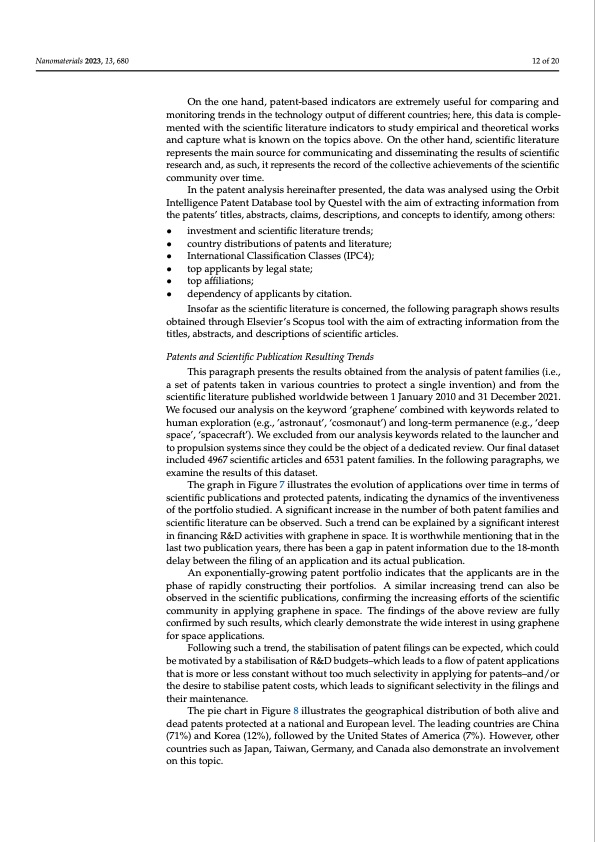
PDF Publication Title:
Text from PDF Page: 012
Nanomaterials 2023, 13, 680 12 of 20 On the one hand, patent-based indicators are extremely useful for comparing and monitoring trends in the technology output of different countries; here, this data is comple- mented with the scientific literature indicators to study empirical and theoretical works and capture what is known on the topics above. On the other hand, scientific literature represents the main source for communicating and disseminating the results of scientific research and, as such, it represents the record of the collective achievements of the scientific community over time. In the patent analysis hereinafter presented, the data was analysed using the Orbit Intelligence Patent Database tool by Questel with the aim of extracting information from the patents’ titles, abstracts, claims, descriptions, and concepts to identify, among others: • investment and scientific literature trends; • country distributions of patents and literature; • International Classification Classes (IPC4); • top applicants by legal state; • top affiliations; • dependency of applicants by citation. Insofar as the scientific literature is concerned, the following paragraph shows results obtained through Elsevier’s Scopus tool with the aim of extracting information from the titles, abstracts, and descriptions of scientific articles. Patents and Scientific Publication Resulting Trends This paragraph presents the results obtained from the analysis of patent families (i.e., a set of patents taken in various countries to protect a single invention) and from the scientific literature published worldwide between 1 January 2010 and 31 December 2021. We focused our analysis on the keyword ‘graphene’ combined with keywords related to human exploration (e.g., ’astronaut’, ‘cosmonaut’) and long-term permanence (e.g., ‘deep space’, ‘spacecraft’). We excluded from our analysis keywords related to the launcher and to propulsion systems since they could be the object of a dedicated review. Our final dataset included 4967 scientific articles and 6531 patent families. In the following paragraphs, we examine the results of this dataset. The graph in Figure 7 illustrates the evolution of applications over time in terms of scientific publications and protected patents, indicating the dynamics of the inventiveness of the portfolio studied. A significant increase in the number of both patent families and scientific literature can be observed. Such a trend can be explained by a significant interest in financing R&D activities with graphene in space. It is worthwhile mentioning that in the last two publication years, there has been a gap in patent information due to the 18-month delay between the filing of an application and its actual publication. An exponentially-growing patent portfolio indicates that the applicants are in the phase of rapidly constructing their portfolios. A similar increasing trend can also be observed in the scientific publications, confirming the increasing efforts of the scientific community in applying graphene in space. The findings of the above review are fully confirmed by such results, which clearly demonstrate the wide interest in using graphene for space applications. Following such a trend, the stabilisation of patent filings can be expected, which could be motivated by a stabilisation of R&D budgets–which leads to a flow of patent applications that is more or less constant without too much selectivity in applying for patents–and/or the desire to stabilise patent costs, which leads to significant selectivity in the filings and their maintenance. The pie chart in Figure 8 illustrates the geographical distribution of both alive and dead patents protected at a national and European level. The leading countries are China (71%) and Korea (12%), followed by the United States of America (7%). However, other countries such as Japan, Taiwan, Germany, and Canada also demonstrate an involvement on this topic.PDF Image | Role of Graphene in Space Technology

PDF Search Title:
Role of Graphene in Space TechnologyOriginal File Name Searched:
nanomaterials-13-00680-v2.pdfDIY PDF Search: Google It | Yahoo | Bing
Salgenx Redox Flow Battery Technology: Power up your energy storage game with Salgenx Salt Water Battery. With its advanced technology, the flow battery provides reliable, scalable, and sustainable energy storage for utility-scale projects. Upgrade to a Salgenx flow battery today and take control of your energy future.
| CONTACT TEL: 608-238-6001 Email: greg@infinityturbine.com | RSS | AMP |